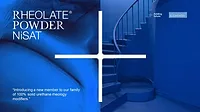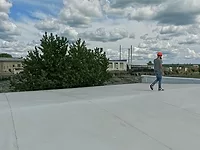A New Rheology Modifier for Waterborne Industrial Coatings: Formulations and Performance
Hydroxyethylcellulose (HEC) is a versatile, water-soluble polysaccharide widely used for thickening many types of flat to semi-gloss architectural latex paints. HEC is commercially available in a range of viscosity grades.1 Paint thickened with HEC exhibits excellent colorant compatibility and excellent storage stability. Paint properties dependent on the HEC molecular weight include thickening efficiency, flow and leveling, spatter resistance, film build, and sag resistance. HEC and other non-associative water-soluble polymers thicken the aqueous phase of paint, and the viscosity achieved is related to the hydrodynamic volume of the water-soluble polymer (WSP) and the degree of chain entanglement of these polymers in solution.2
Hydrophobically modified hydroxyethylcellulose (HMHEC) polymers were commercially introduced in 1984. HMHEC polymers thicken the aqueous phase of paint and also thicken by association of the hydrophobes. HMHEC polymers associate with other thickener molecules and other paint ingredients, such as dispersants, surfactants, and coalescing solvents.3
Hercules Inc. has recently commercialized a new low-molecular-weight HMHEC that provides superior flow and leveling, improved gloss development, better spray application, and enhanced corrosion resistance relative to traditional HMHEC polymers. HMHEC 100 yields paint that has comparable gloss and film performance to urethane thickened coatings. It provides superior sag resistance compared to urethane thickened coatings, and offers formulators a new tool to achieve maximum performance in spray-applied industrial waterborne coatings.
Performance Deficiencies of Waterborne Industrial Coatings
Growth of waterborne industrial coatings is limited by a number of factors. Waterborne coatings often cost more and frequently do not perform as well as the coatings currently being used. Dry time, temperature and humidity sensitivity, and durability all need to be improved. The relative costs of waterborne coatings may improve as the raw materials achieve higher production volumes. The raw materials chosen will impact the paint properties. Gloss, sprayability, sag resistance, and water resistance are dependent on the choice of additives and the latex polymer being used. Formulating a waterborne coating requires careful selection of the types and amounts of each additive to obtain the needed balance of properties. There are many product choices for each functional additive, and each contributes certain features to the final formula.
Characteristics of Rheology Modifiers
Many types of rheology modifiers are used in waterborne coatings. These include clays, alkali-swellable polymers (ASE, HASE) hydrophobically modified urethane associative polymers (HEUR) and derivatives of cellulose (HEC, HMHEC).Coatings thickened with HEURs generally demonstrate excellent gloss, flow and leveling, sprayability, and corrosion resistance. However, these coatings usually exhibit poor sag and syneresis resistance. A conventional high-molecular-weight HMHEC provides excellent sag and syneresis resistance, but paint thickened with high molecular weight cellulose derivatives often display poor sprayability, poor flow and leveling, poor corrosion resistance, and low gloss. Gloss and corrosion deficiencies in HMHEC-thickened paint are often ascribed to latex or paint flocculation.
Water-soluble polymers such as rheology modifiers may flocculate the latex and the pigment. Bridging flocculation results from strong associative interactions between the WSP and the latex particles. Depletion, or volume restriction flocculation, is dependent on the size of the WSP in solution, the size of the latex particles, and the concentrations of the WSP and the latex polymer. Small particle size latexes are more prone to flocculation, due to the intrinsically higher particle concentration. In general, minimizing flocculation in a paint should improve the stability and the performance properties of that paint.
The rheological properties of the paint determine the sprayability, flow and leveling, and sag resistance. The steady shear rate viscosity of paint is the sum of the elastic or storage modulus G’, and the viscous or loss modulus G”. The elastic modulus represents resistance to flow and the spring-like character of the fluid. The loss modulus represents the flow of the fluid without memory effects. Increasing the elasticity in a coating improves the sag resistance, but reduces the flow and leveling. Reducing the elasticity of a coating should improve sprayability, and may improve gloss.
Figure 1 shows the results of a study in which HMHEC polymers of varying molecular weight were prepared and evaluated in a gloss paint. The rheological characteristics of these coatings were separated into the elastic component G', and the viscous modulus G". It illustrates that the elastic modulus increases as the molecular weight of the HMHEC increases. At low HMHEC molecular weights, the elastic component contributes less to the viscosity, and the viscous component dominates. Paint containing this type of rheology modifier is expected to demonstrate improved flow, leveling, and sprayability compared to paint thickened with higher-molecular-weight HMHEC 330.4
HMHEC 100 was developed to combine HEUR-like and conventional HMHEC properties in waterborne coatings. The low molecular weight of HMHEC 100 is expected to minimize paint flocculation. To test the prediction of less flocculation in latex thickened with HMHEC 100, mixtures of a small particle size styrene-acrylic latex, coalescent and thickener were prepared. The unpigmented systems were allowed to equilibrate and were then flash frozen. Four SEM photomicrographs at identical magnification are shown in Figure 2. The rheology modifiers studied are HEC 250HBR, HMHEC 330, HMHEC 100 and HEUR 708.5
The particle appearance in the HMHEC 100 system is identical to that of the latex without added thickener. The particle size and distribution in these systems may relate to the film integrity of the paint. Good coalescence depends on the uniform distribution of latex particles throughout a sample. Coatings with flocculated particles will require additional particle deformation to coalesce into a tight, void-free film. Voids in a paint film will compromise the surface protection and may reduce the gloss. The HEC and HMHEC 330 paints with large gaps, large particles and smaller particles will not coalesce easily into a void-free film. The HEUR and HMHEC 100 samples would be expected to provide superior film performance.
Next, clear films were prepared by drawdowns, dried for 14 days and tested. These data are shown in Table 1. HMHEC 330, HEUR 708 and HMHEC 100 had comparable 60° gloss readings. Water absorption and permeability were measured on free films. The water absorption was higher for the HEC 250 and HMHEC 330 clears than for the HEUR 708 or HMHEC 100 clears. The water permeability was lower for the HEUR 708 and HMHEC 100 clears. The water absorption data and low permeability observed for the HEUR and HMHEC 100 are consistent with the predictions of improved properties resulting from less-flocculated systems.
An anti-corrosive primer based on a small particle size styrene-acrylic latex was prepared (see Anti-Corrosive Primer Formulation sidebar). This formulation was modified with an epoxy ester to improve the adhesion to steel. An unthickened base paint was prepared, divided and thickened to equal Stormer (KU) viscosities at equal weight solids. These paints were spray applied to cold-rolled steel panels, aged 14 days and exposed to salt spray for 200 hours. Paint performance data is shown in Table 2. The paint with HMHEC 100 has improved corrosion resistance compared to HMHEC 330. This is consistent with the expectations that prevention of latex flocculation improves the paint performance. In this formulation, the paint with HMHEC 100 also demonstrates improved corrosion resistance compared to the HEUR 708 thickened paint.
Photos of the corrosion test panels are shown in Figure 3. These paints are all at the same film build, and the only formulation difference is the type and amount of thickener. In general, it was found that the corrosion performance of paints thickened with HMHEC 100 is better than or equal to paint thickened with HEUR modifiers.
Dispersants, surfactants and coalescing solvents influence HMHEC 100 performance in coatings. The amount of the additive, as well as its hydrophilic or hydrophobic nature, is important. Table 3 shows the impact of dispersant type and level on HMHEC 100 performance in a gloss coating. Dispersant 681 is more hydrophobic than Dispersant 1124, and reduces the efficiency of HMHEC 100 in this paint. As in any formulation, careful evaluation of the dispersant type and level is necessary to optimize paint performance.
The choice and amount of coalescing solvent may also affect thickener performance. The partitioning of the solvent between the continuous water phase and the polymer phase of the paint may impact the thickening efficiency and other properties. The coalescing solvent is intimately involved in film formation, and may also impact properties such as gloss, corrosion resistance, water resistance, adhesion, and dry time. Formulation of the best possible coating for a given application always requires compromises between the desired properties and the performance demonstrated by the coating.
Performance of Waterbonern Industrial Coatings
HMHEC 100 provides improved sag resistance compared to HEUR-thickened paint at the same viscosity. This allows spray application of higher film builds before sag is observed. Higher film build per coat could result in lower application costs. Some of the systems tested for increased spray sag resistance are shown in Table 4. The improved sag resistance is accompanied by equal or improved performance for all of these formulations.A topcoat based on Maincote® AE-58 was prepared. Part A was post thickened to 75 KU. HEUR 708 was used as received to thicken these paints, while HMHEC 100 was used as an 8% solution in water. Properties of the wet paint and of the cured film are shown in Table 5. The corrosion and water resistance are comparable for these paints.
Thickening a 2K epoxy primer in the hardener package demonstrated improved efficiency for HMHEC 100 compared to HEUR 8. The performance is summarized in Table 6. Notice that the sag resistance of the HMHEC 100 paint is higher than that for the HEUR 8 paint.
Another example is a gloss direct-to-metal paint based on Pliotec LS-1 styrene-acrylic latex from Goodyear. This paint showed good gloss, wet adhesion and salt-spray resistance. The performance is listed in Table 7. Sag resistance was improved in this paint.
The improved water resistance offered by using HMHEC 100 is illustrated in a clear wood coating. Everyone is familiar with the unofficial “white-ring test” that occurs when a wet glass is placed on a piece of furniture. Figure 4 shows the results from a “hot-pan” test. The hot-pan test involves placing a wet beaker filled with boiling water on the film for one hour. The beaker is then removed, and the film is examined for cloudiness and softening. In this example, the wood lacquer containing HMHEC 100 shows improved performance over HASE and HEUR thickeners. The wood lacquer formulation is shown in the Wood Lacquer sidebar.
Conclusion
In conclusion, HMHEC 100 allows the formulator to improve the performance of waterborne industrial coatings.- HMHEC 100 is a single rheology modifier that provides a desirable rheology profile that generally requires two or more rheology modifiers.
- The material provides excellent sprayability, sag resistance, flow and leveling, gloss, and good resistance to pigment settling.
- It allows for a wide range of application techniques, including airless spray.
- It has no negative impact on the film formation of small particle size latexes. Good film formation results in good water resistance, good corrosion resistance, and good gloss.
- It is compatible with a range of coalescing solvents and other paint ingredients, resulting in wide formulation latitude.
So, when HMHEC 100 is compared to HEUR 708 and other urethane-type thickeners, it is shown that HMHEC 100 solves the performance deficiencies noted earlier for the higher molecular weight HMHEC thickeners. HMHEC 100 is also an improvement over materials that were previously available, and provides formulators with a new tool to improve the properties of waterborne industrial coatings with appropriate balance in quality, performance, and cost. c
For more information on rheology modifiers, contact Hercules Incorporated, Aqualon Division, 1313 N. Market St., Wilmington, DE 19894; phone 800/345.0447; e-mail aqualon@herc.com; visit www.herc.com;
Links
Looking for a reprint of this article?
From high-res PDFs to custom plaques, order your copy today!






